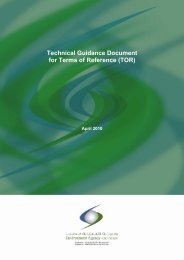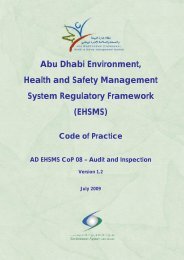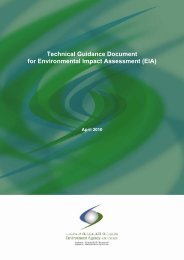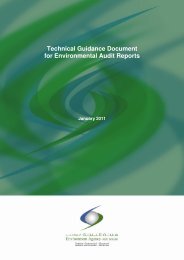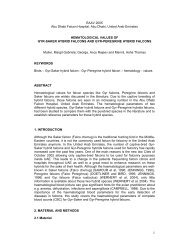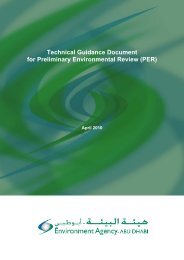Standard Operating Procedure (SOP) for Compliance Monitoring ...
Standard Operating Procedure (SOP) for Compliance Monitoring ...
Standard Operating Procedure (SOP) for Compliance Monitoring ...
Create successful ePaper yourself
Turn your PDF publications into a flip-book with our unique Google optimized e-Paper software.
Application of the CEMS at Thermal Power Plants<br />
1.1.1.1 Dilution-Extractive Systems<br />
Most of the SO 2 CEMS and approximately one half of the NO x CEMS installed at U.S. electric utility<br />
power plants to meet U.S. EPA monitoring requirements were dilution-extractive systems. These<br />
types of systems are extractive systems that dilute the sample gas with dry contamination-free dilution<br />
air to a level below the dew point of the diluted flue gas to eliminate condensation problems in the<br />
CEMS (in lieu of using a moisture condenser). The main reason <strong>for</strong> selecting a dilution-extractive<br />
system is its ability to measure flue gas pollutant concentrations on a wet basis. Many SO 2 emissions<br />
standards applicable to thermal power plant in the United States require emissions to be reported as a<br />
mass emissions rate (i.e., kilogrammes [kg] of sulphur dioxide per hour [SO 2 /hr]). All flue-gas flowrate<br />
measuring techniques are on a wet basis; consequently, wet basis SO 2 emissions data can be used<br />
more conveniently to calculate SO 2 mass emissions rates. Additionally, the requirement to measure<br />
CO 2 added to the convenience of using a dilution-extractive system because CO 2 is measured as the<br />
diluent gas (instead of O 2 ) in dilution-extractive systems. The diluted sample is analysed by pollutant<br />
and CO 2 monitors operating at or near ambient concentration ranges. The most unique component of a<br />
dilution-extractive system (relative to other extractive systems) is the dilution-sampling probe. There<br />
are two basic types of dilution-extractive probes: in-stack, in which the dilution of the flue gas is<br />
per<strong>for</strong>med in the probe, and out-of-stack (ex situ).<br />
• In-stack dilution-extractive probe. The in-stack probe design is equipped with coarse and<br />
fine filters <strong>for</strong> removing PM from the stack gas prior to sample dilution, a quartz or glass<br />
critical orifice <strong>for</strong> flow regulation, and an air-driven aspirator and venturi <strong>for</strong> dilution of the<br />
sample gas. Approximately 86.4% and 81.0% of the SO 2 and NO x , respectively, of the<br />
dilution-extractive systems used are the in-stack type.<br />
• Out-of-stack dilution-extractive probe. The out-of-stack device uses the same basic<br />
dilution-extractive sampling technology as the in-stack dilution-extractive probe; however,<br />
the out-of-stack device is designed to constantly heat the sampling assembly and all critical<br />
parts are mounted out of the stack <strong>for</strong> quick access and easy maintenance.<br />
The principle difference is that undiluted stack gas is continuously drawn through the sampling probe<br />
tube into the sampling chamber by a bypass pump at a rate of 1.5 litres per minute (Lpm) to 15 Lpm.<br />
A vent in the sampling chamber ensures a constant flow of “fresh” stack gas through the sampling<br />
chamber. The dilution probe draws a small sample of the gas out of the sampling chamber through a<br />
sampling tube at a flow rate determined by the critical orifice of the probe. The operation of the<br />
dilution-extractive probe at this point is the same as previously described.<br />
Dilution air-cleanup system. Dilution-extractive probe systems require a constant source of<br />
contamination-free dilution air. The compressed air supply should be dry and delivered at constant<br />
pressure (e.g., approximately 6.3 kilogrammes per square centimetre [kg/cm 2 ]). Additionally, the<br />
dilution air should be free of oils, particulates, CO 2 , NO x , and SO 2 . A plant’s compressed air system<br />
does not generally provide dilution air to the needed specification; there<strong>for</strong>e, an additional air-cleanup<br />
system is required. In U.S. dilution-extractive CEMS, the air-cleanup system is the critical component<br />
of the dilution-extractive system. Compressed air either from the plant’s compressed air supply or<br />
from a dedicated air compressor is first filtered <strong>for</strong> particulates, and then liquid and oils condensate by<br />
a coalescing filter. Oil removal is necessary to prevent the contamination of silica gel or other drying<br />
agents in the heatless air dryer. Additional drying of the dilution air is per<strong>for</strong>med by a heatless dryer<br />
that can dry the air to approximately −73°C. The CO 2 extractor uses two columns with different<br />
adsorbent materials to adsorb any CO 2 in the dilution air. Some air cleaning systems may add a CO to<br />
CO 2 converter be<strong>for</strong>e the CO 2 extractor if the analysers respond to interferences from CO. A charcoal<br />
filter trap may also be added to remove any hydrocarbons that may be in the dilution air. An<br />
additional desiccant dryer may be added to provide additional moisture removal. A submicron filter<br />
removes any particulates that may be released from the upstream desiccant traps.<br />
Gas sample dilution ratios. Dilution ratios typically range from 50:1 to 300:1. The dilution ratio most<br />
widely used by U.S. sources is 100:1. The sample gas flow rates from the various dilution probes<br />
range from 50 millilitres per minute (mL/min) to 300 mL/min. Two criteria are used to determine the<br />
A1-2





